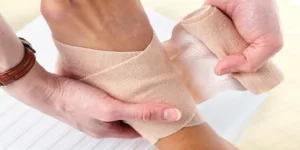Painful and debilitating leg ulcers are a commonly misunderstood issue among adults. Learning about how and why leg ulcers develop and viable treatment options for the condition is beneficial in getting people back to health quickly.
Problems with the legs and veins are often seen in older adults, but most chock these health issues up to the natural aging process. While that’s partly to blame for unsightly bumps and lumps on the lower extremities, individuals may have an underlying condition that requires some medical intervention. Leg ulcers – long-lasting sores found on the leg – occur in an estimated one in every 50 adults over the age of 80, and one in 500 in younger age groups, but there is a widespread misconception that this condition isn’t one to be concerned about. Here’s what people should know about leg ulcers, their causes and warning signs, and methods to treat underlying issues.
Breaking Down Leg Ulcers
Put simply, leg ulcers are defined as a sore that takes significantly more time to heal than another wound. On average, a leg ulcer will remain for four to six weeks, with a break in the skin allowing bacteria and air into the wound constantly. This onslaught of invaders can lead to an infection that is both incredibly painful and challenging to correct. Leg ulcers may leak fluid, have a poignant smell, itch, or swell, all which quickly lead to discomfort until the wound is properly healed.
While leg ulcers are relatively common among older adults, the reason behind the development of a leg ulcer isn’t well known. Nearly 85% of leg ulcers are caused by a venous reflux complication, meaning the blood flows backward in the leg. Instead of the veins working properly to move blood back to the heart, faulty valves create pooling and varicose veins that are bulging and dark in color beneath the skin. Varicose veins caused by venous reflux may be difficult to see at first glance, and there may be no symptoms present. However, left untreated, venous issues can lay the groundwork for leg ulcers should an individual experience an injury to the leg or ankle.
Who is at Risk?
Leg ulcers caused by varicose veins are found most often in individuals who have previously experienced deep vein thrombosis, or those who have another ailment affecting their ability to walk or move. Older individuals with osteoarthritis, a past leg injury, or paralysis are prone to developing venous reflux which could ultimately lead to a leg ulcer. Similarly, people who have a family history of vein disorders are more likely to develop varicose veins as they age. In some cases, pregnant women, people who carry excess weight, and those who have had an operation on the leg like a hip or knee replacement develop vein issues that can cause leg ulcers.
Options for Treatment
When leg ulcers are a product of venous disorder and subsequent varicose veins, there are several courses of treatment that can be recommended by a specialist or primary care doctor. Vein specialist Eddie Chaloner explains that there have been several breakthroughs in vein correction and treatment in recent years, including the addition of minimally-invasive procedures that prevent varicose veins from returning for some patients. He also shares that while it is important to treat the symptoms like leg ulcers, it is far more beneficial to individuals to focus on the underlying condition in an effort to prevent painful ulcers from returning in the future.
Endovenous vein treatment, also known as EVLT, is one of the minimally invasive corrective actions that can be taken to address the problem of venous reflux and varicose veins. Through this procedure, an IV is placed into the disrupted vein, and a laser is inserted to seal the vein. Over time, the body absorbs the faulty vein, making it invisible to the naked eye. The healthy veins around the treated area take over the normal blood flow, leaving individuals with less potential for venous reflux and leg ulcers as a result.
More conservative treatment options include compression therapy, elevation, and changing lifestyle habits to prevent venous reflux from reoccurring. Through compression therapy, patients are given graduated compression stockings to be worn for extended periods of time to help the blood flow easier throughout the legs. Elevation is also beneficial in easing the symptoms of venous reflux, as raising the legs above the heart for brief intervals helps blood move freely without pooling.
A shift in diet, maintaining an active lifestyle, and losing weight may also benefit individuals with venous disorders over time. Overall, people who have experienced leg ulcers or those at risk of developing varicose veins can take several steps to prevent leg ulcers from happening again in the future, so long as the underlying condition is identified and treated properly.








